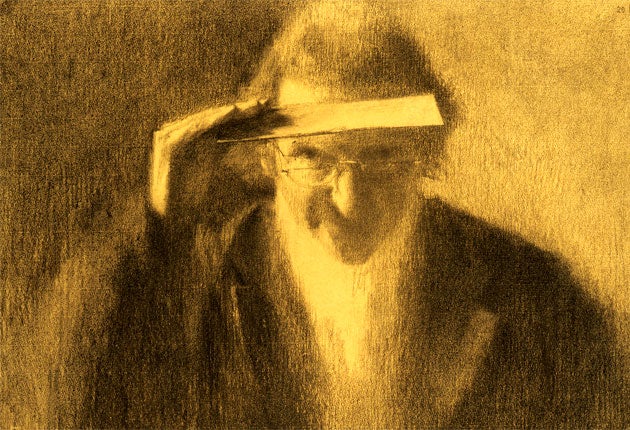John Sergeant: Draughtsman celebrated for his still lifes and self-portraits

As a black-and-white draughtsman John Sergeant was supreme; he loved chiaroscuro and relied almost entirely on the tint of his carefully chosen Ingres papers to illumine and enrich the subtlety of his lustrous black charcoal drawings. He regarded colour as an intrusive and unnecessary distraction, though he did allow himself the occasional indulgence when the subject, such as a stylish pair of 1940s red shoes, or the eyelet on a luggage-tag, dictated.
Like his 18th-century predecessors, drawing was for him not only an act of creation, but a quest for information. In the catalogue for his most recent exhibition, at Colnaghi's in March 2006, he described himself as a "serious serial draughtsman who explores, scrutinizes the same subject back, front, sideways, this way and that. It is all part of trying to understand". He was always acutely aware that the patterns he created out of the often bizarre objects that filled his studio – ranging from broken crockery, a set of jockey's colours and bits of fishing tackle to fairground horses – the viewer would have to be able to reinterpret back into reality.
John Sergeant was born in London in 1937, the son of a civil servant who, after the bombing, moved the family to Faversham in Kent. Kent remained the geographical focus of his life before a final move in 1983 to a beautiful rural Welsh retreat close to Builth Wells, Powys. He studied at Canterbury College of Art from 1954-57, during which period he met John Ward, who was to become a lifelong supporter, and in 1959, with Ward's encouragement, he entered the Royal Academy Schools. During his final year there, 1962, he won the Drawing Prize and married a fellow student, Carolyn Cann.
The marriage was to be a fruitful collaboration and John's and Carolyn's careers blossomed in parallel. During the ensuing decades John took teaching posts at Canterbury College of Art, and the Art Schools at Dover and Folkestone, while Carolyn juggled family responsibilities – their sons Ben and Edward were born in 1971 and 1975 – and pursued her own career as a painter. As Carolyn Sergeant, she is now highly esteemed for her exquisite and carefully arranged botanical still lives.
Inspired by an exhibition, Interiors, at Hazlitt, Gooden & Fox in 1981, Sergeant secured commissions to make a series of room-portraits of his own, visiting Castle Coole, Stowell Park and Deene Park among others; the drawings he made of Erddig were acquired by the National Trust. He has described how, while making these room-portraits, his attention would be attracted by cards propped on the mantelpiece, flowers in pots, piles of books or discarded newspapers. From this grew his delight in still-life drawing. Few artists have rendered the trivia of life – buckles, buttons, shells, a tin of sardines or a candle flame – so exquisitely, giving immortality to the ephemeral. In 1994, his work was shown in "Three Contemporary Masters" alongside that of John Ward and Jehan Daly.
John had previously had three exhibitions at the Maas Gallery in Clifford Street, culminating in 1992 with a show of works done in Prague, where he accompanied the Prince of Wales on an official visit. To their embarrassment, on the night the Prince came to view the exhibition, Sergeant and Rupert Maas strolled back to the gallery after a leisurely dinner to find His Royal Highness waiting patiently on the doorstep, with a bodyguard posted either end of the street. The Prince's equerry had mistaken the time.
Like Seurat, charcoal estompé on Ingres paper was Sergeant's favourite medium, and some of his simplest drawings, such as that of a tailor's dummy, "Divine Proportions", have the statuesque dignity of the French master. He would use charcoal in much the same way as a sculptor uses clay, teasing out the modulation of his subject, working from rich black to the very palest shades of greys, just leaving small areas of untouched paper for the highlights; or, if using a dark paper, these might be enhanced by the application of a little Chinese white.
Although still life became his abiding love, he produced a remarkable series of self-portraits, much in the manner of the 18th-century Irish artist Thomas Frye. He studied his own face with the same dispassionate rigour he applied to inanimate objects, and, through these, future generations will have the pleasure of knowing this gentle, eccentric, quizzical character. To hear him enthusing in front of a Palmer or Brockhurst etching was to witness a master of black and white in thrall to his peers. He would marvel at how Palmer could imbue his darkest print, "The Weary Ploughman", with such luminosity, or speculate on how Brockhurst achieved the velvety richness of his blacks.
It was this interest in other people's work that made him such an inspiring teacher, and it was a sad day when, in terminating his post at Folkestone, the principal told him that drawing was no longer regarded as a necessary basis for painting. Sergeant regarded drawing as being sparer and more stringent than painting and he devoted his life to disproving such iconoclasm, quoting with pleasure Sickert's statement: "If you can draw you can paint. All you need to know, as Whistler used to say, is which end of the brush to put in your mouth."
Peyton Skipwith
John Sergeant, draughtsman: born London 5 June 1937; married 1962 Carolyn Cann (two sons); died 7 January 2010.
Join our commenting forum
Join thought-provoking conversations, follow other Independent readers and see their replies
Comments
Bookmark popover
Removed from bookmarks